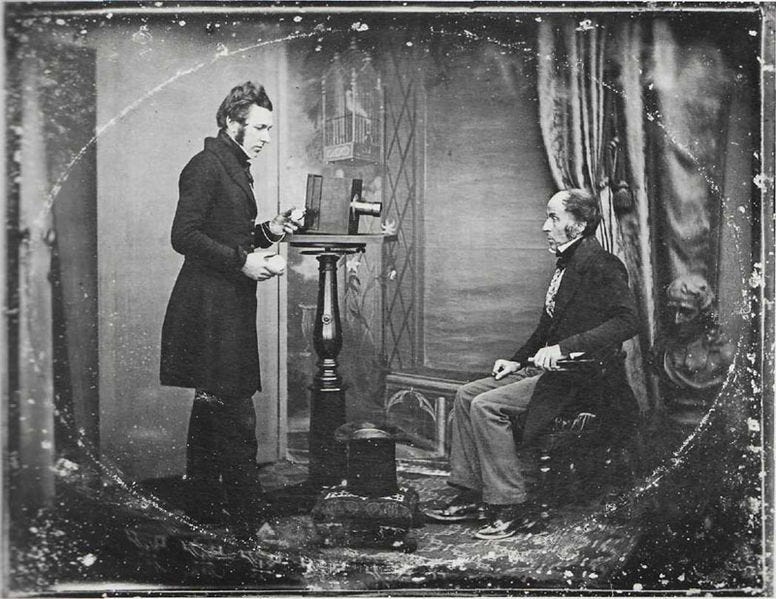What are three subjects romantics favored. They were interested in history legends and folklore.

How Photography Became An Art Form By Aaron Hertzmann Medium
1839-1914 tells the not so simple story of how photography came.

. Photography democratised art by making it more portable accessible and cheaper. Art Appreciation InQuizitive 28 - Photography. How did photography influence the development of painting.
Photo-realist painters created highly illusionistic images that referred not to nature but to the reproduced image. In the long-running debate about whether photography is an art form or not critics have cited the idea that the medium is not artistic because it is capable only of representing the real world. Photography and Art History.
While some artist appreciates the development of photography and embraces the impact towards their own works. Architecture was also influenced by photography. How if at all did the invention of photography influence the development of modern art.
How did photography influence painting. How did photography influence the development of painting. Some artists such as.
From Da Vincis interest in pre-natal anatomy to Van Goghs study of Astronomy to the post. Photo-realism also called Super-realism American art movement that began in the 1960s taking photography as its inspiration. How did photography influence Impressionist painting.
Photography radically changed painting. In the early stages of camera development long exposures with a camera were required to capture the image which created shutter-drag allowing for beautiful fluid movement and gracefully blurred selections. For instance as photographed portraits were far cheaper and easier to produce than painted portraits portraits ceased to be the privilege of the well-off and in a sense became democratised.
An artist can look at a photograph and get a new idea out of it and create a new abstract image. With the development of photography nineteenth-century painters were challenged with setting themselves apart from the new medium. Realists had tasked themselves with accurately representing the visual world but now a photographer could do this with the flash of a bulb.
They wanted to stir the emotions. Chronophotography or what is now referred to as time-lapse photography influenced the development of the work of Cubist and Futurist painters in the early 20th century. Some artists such as.
Portable cameras could also be taken outdoors to record landscapes enabling the painting process to be completed in the studio. Portable cameras could also be taken outdoors to record landscapes enabling the painting process to be completed in the studio. A third way that photography has transformed the art of non-photographic artists is that more abstract art can be created from photographs.
They had a lot of different ideas that impacted other artists and became a new direction for them and their career. In the 40s and 50s Jackson Pollock Robert Motherwell and other Abstract Expressionists pushed this trend to the point where painting had left behind representations of the physical world. In the early stages of camera development long exposures with a camera were required to capture the image which created shutter-drag allowing for beautiful fluid movement and gracefully blurred selections.
Photography radically changed painting. The cameras influence was apparent in the visual characteristics of paintings the subject matter and the powerful direction in which artists were able to take their creative visions. What are three subjects romantics favored.
The realism of photography made some artists turn away from realistic painting. Celebrated nature and dramatic action. Celebrated nature and dramatic action.
Until now photography has a profound influence on paintings ever since optical devices were introduced in the art society. For instance as photographed portraits were far cheaper and easier to produce than painted portraits portraits ceased to be the privilege of the well-off and in a sense became democratised. However the concept of photography influencing painting has been very controversial.
The relationship of sciencetechnology and art is woefully underemphasized in popular understanding. How did photography influence the development of painting. They were interested in history legends and folklore.
As photography evolved from a mere mechanical means of reproducing reality to gaining artistic credibility it allowed painters a closer examination of light and asymmetrical cropped spaces as well as an exploration of spontaneity and visual ambiguity. Art 24022020 0210 ritikkhatana235 How did photography influence the development of painting. The overall idea of the invention of photography and development of painting is that photography dramatically changed the way that painters used their ideas and how the outcome of their pieces came out.
The realism of photography made some artists turn away from realistic painting. Just as significant if not more so the development of photography influenced art in the second half of the nineteenth century. Photography democratised art by making it more portable accessible and cheaper.
Photography only began to develop in the 19th century so it has a much shorter history than painting. They wanted to stir the emotions. Dominique de Font-Réaulx s simply titled Painting and Photography.

How Did Photography Influence The Development Of Painting Study Com

How Photography Changed Art Seniorcare2share

How Photography Became An Art Form By Aaron Hertzmann Medium
How The Invention Of Photography Changed Art Pearey Lal Bhawan

How Photography Cast New Light On Art The New York Times

A New Culture Chapter 9 Section Ppt Video Online Download


0 comments
Post a Comment